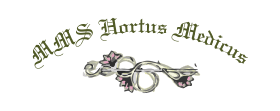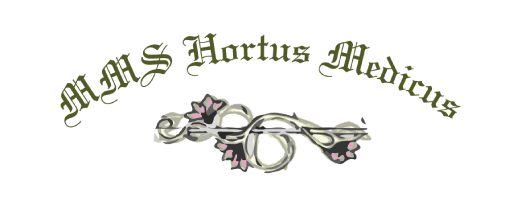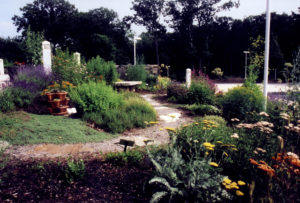When the Church created the university system in Europe in the Early Renaissance (from the 14th to the 17th century), all the medical schools had a garden tended by their students. Because Latin was the language of instruction at the time, all the medicinal gardens bore the same Latin name, HORTUS MEDICUS . Therefore, in keeping with this old academic medical tradition, we chose to give that name to our medicinal garden.
The purpose of the garden is to teach medical history; it is to neither advocate nor recommend specific treatments for specific medical disorders. The plants chosen span six millennia of recorded medical history that begins with the opium poppy, Papaver somniferum. The opium poppy, called the “joy poppy” by the Sumerians, is the first medicinal plant to have had its properties recorded in writing. The Sumerians described the effects of ingesting the sundried white latex harvested from the unripe poppy pods. This latex was named opion by the Greeks from which comes the English word opium. Opium is the natural source of the opiates (e.g., morphine, thebaine, etc.) and the source of opioids, which are laboratory derivatives of opiates (e.g., oxycodone and hydrocodone).
During any given growing season, specimens of more than 90 different medicinal plants are grown, including some that are very important in current pharmaceutical research done by the biotechnology industry and others for the development of chemotherapeutic agents. These include (1) Podophyllum peltatum, the May Apple, source of Etoposide and Tempocide for the treatment of cancer of the testicle and small cell lung carcinoma; and (2) Catharanthus roseus, a.k.a. Vinca roseus or the Madagascar Periwinkle, the source of Vincristine, Vinblastine, Vindesine, and Vinrelbine, which are used to treat a variety of malignant diseases.
For historical reasons, the medicinal garden also includes the following: plants from which preparations were used very effectively in the past but now have been replaced by more effective remedies (e.g., Chrysanthemum parthenium, or Feverfew, for the treatment of migraine, etc.); plants that are of questionable value (e.g., Echinacea purpura, or the Purple Cone Flower, thought to stimulate the immune system at the first signs of an upper respiratory infection and to lessen the severity and duration of the common cold); and plants proven to have no medicinal value but were used widely for a long time, such as Physalis alkekengi, or Chinese Lanterns, the seeds of which are not beneficial in the treatment of urinary bladder diseases as once thought. It also contains uninvited guests that are welcome to stay: Aescelapius syriaca (milkweed), Taraxacum officinale (dandelion), and Dauca carota (Queen Anne’s Lace). All three of these wild plants have medicinal properties. Dandelion and Queen Anne’s Lace have nutritional as well as medicinal properties; because of their dual benefits, they are often referred to as “nutraceuticals.” All of these categories have a place in medical history, so they deserve recognition in our garden.
The history of medicine cannot be told without devoting chapters to plants, including trees and shrubs. In all cultures and at all times, humans have assiduously sought cures for diseases and agents for the relief of pain and suffering in plant materials. To a lesser extent, they have searched for these remedies in minerals. Currently, it is estimated that at least 60 percent of the inventory of any pharmacy anywhere in the world contains therapeutic agents that have at least one plant-based ingredient in them.
The search for agents in plants to prevent and cure disease, to relieve physical pain and mental suffering, and to treat mood disorders (anxiety and depression) will never cease. As recently as two years ago, the Nobel Prize in Medicine and Physiology was awarded to a Chinese scientist for the discovery of a very effective antiparasitic agent in the treatment of malaria. Dr. Tu Youyou engaged in research for many years with ancient medicinal plants for the specific purpose of seeking a cure for malaria. Her persistent search paid off. From Artemisia annua, an alkaloid given the name artemisinin was extracted that has resulted in saving millions of lives from malaria. Because the parasite has mutated over time, the previously effective treatments of malaria, by either quinine, chloroquine, or hydroxychloroquine, are now no longer sufficiently effective in the treatment of the majority of cases of malaria.
Treatments that are effective today may cease to be effective tomorrow; hence, they will need to be replaced. In some cases, the replacements may come from newly discovered medicinal plants.



